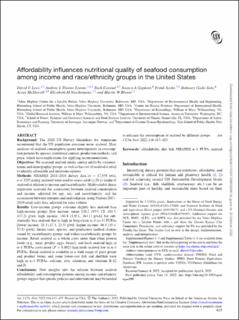| dc.contributor.author | Love, David C. | |
| dc.contributor.author | Thorne-Lyman, Andrew L. | |
| dc.contributor.author | Conrad, Zach | |
| dc.contributor.author | Gephart, Jessica A. | |
| dc.contributor.author | Asche, Frank | |
| dc.contributor.author | Godo-Solo, Dakoury | |
| dc.contributor.author | McDowell, Acree | |
| dc.contributor.author | Nussbaumer, Elizabeth M. | |
| dc.contributor.author | Bloem, Martin W. | |
| dc.date.accessioned | 2023-03-28T06:16:23Z | |
| dc.date.available | 2023-03-28T06:16:23Z | |
| dc.date.created | 2022-10-24T14:06:53Z | |
| dc.date.issued | 2022 | |
| dc.identifier.citation | Love, D. C., Thorne-Lyman, A. L., Conrad, Z., Gephart, J. A., Asche, F., Godo-Solo, D., ... & Bloem, M. W. (2022). Affordability influences nutritional quality of seafood consumption among income and race/ethnicity groups in the United States. The American journal of clinical nutrition, 116(2), 415-425. | en_US |
| dc.identifier.issn | 0002-9165 | |
| dc.identifier.uri | https://hdl.handle.net/11250/3060623 | |
| dc.description.abstract | Background
The 2020 US Dietary Guidelines for Americans recommend that the US population consume more seafood. Most analyses of seafood consumption ignore heterogeneity in consumption patterns by species, nutritional content, production methods, and price, which have implications for applying recommendations.
Objectives
We assessed seafood intake among adults by socioeconomic and demographic groups, as well as the cost of seafood at retail to identify affordable and nutritious options.
Methods
NHANES 2011–2018 dietary data (n = 17,559 total, n = 3285 eating seafood) were used to assess adult (≥20 y) intake of seafood in relation to income and race/ethnicity. Multivariable linear regression assessed the association between seafood consumption and income, adjusted for age, sex, and race/ethnicity, and the association between nutrients and seafood price, using Nielsen 2017–2019 retail sales data, adjusted for sales volume.
Results
Low-income groups consume slightly less seafood than high-income groups [low income: mean 120.2 (95% CI: 103.5, 137.2) g/wk; high income: 141.8 (119.1, 164.1) g/wk] but substantially less seafood that is high in long-chain n–3 (ω-3) PUFAs [lower income: 21.3 (17.3, 25.5) g/wk; higher income: 46.8 (35.4, 57.8) g/wk]. Intake rates, species, and production method choices varied by race/ethnicity groups and within race/ethnicity groups by income. Retail seafood as a whole costs more than other protein foods (e.g., meat, poultry, eggs, beans), and fresh seafood high in n–3 PUFAs costs more (P < 0.002) than fresh seafood low in n–3 PUFAs. Retail seafood is available in a wide range of price points and product forms, and some lower-cost fish and shellfish were high in n–3 PUFAs, calcium, iron, selenium, and vitamins B-12 and D.
Conclusions
New insights into the relation between seafood affordability and consumption patterns among income and ethnicity groups suggest that specific policies and interventions may be needed to enhance the consumption of seafood by different groups. | en_US |
| dc.language.iso | eng | en_US |
| dc.publisher | Elsevier | en_US |
| dc.rights | Navngivelse 4.0 Internasjonal | * |
| dc.rights.uri | http://creativecommons.org/licenses/by/4.0/deed.no | * |
| dc.title | Affordability influences nutritional quality of seafood consumption among income and race/ethnicity groups in the United States | en_US |
| dc.type | Peer reviewed | en_US |
| dc.type | Journal article | en_US |
| dc.description.version | publishedVersion | en_US |
| dc.rights.holder | The authors | en_US |
| dc.subject.nsi | VDP::Samfunnsvitenskap: 200 | en_US |
| dc.source.pagenumber | 415-425 | en_US |
| dc.source.volume | 116 | en_US |
| dc.source.journal | American Journal of Clinical Nutrition | en_US |
| dc.source.issue | 2 | en_US |
| dc.identifier.doi | 10.1093/ajcn/nqac099 | |
| dc.identifier.cristin | 2064484 | |
| cristin.ispublished | true | |
| cristin.fulltext | original | |
| cristin.qualitycode | 2 | |

